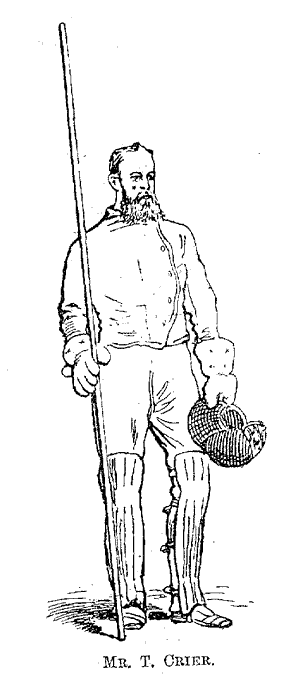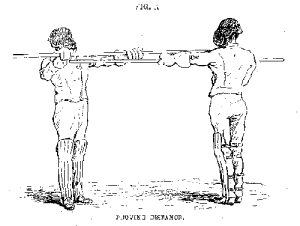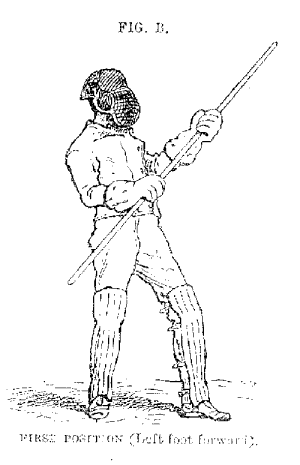QUARTER-STAFF: A PRACTICAL MANUAL
Journal of Manly Arts
Sept 2001
BY THOMAS A. McCARTHY
AUTHOR OF "CALISTHENIC DRILLING", ETC.
Sixteen years an Instructor,
Late Sergeant Instructor 7th R.F. and 65th Regiments
WITH TWENTY THREE FIGURES OF POSITIONS
LONDON:
W. SWAN SONNENSCHEIN & CO.,
PATERNOSTER ROW.
1883
PREFACE
 THE object of the author in compiling this little work is to fill an
evident gap, there not being any special treatise in existence upon the
once-popular art of Quarter-staff. The Exercises have been carefully chosen
from those that the author has himself used, during sixteen years' experience,
some of which Exercises are used by Amateurs and Instructors, both at drill
and in public performances.
THE object of the author in compiling this little work is to fill an
evident gap, there not being any special treatise in existence upon the
once-popular art of Quarter-staff. The Exercises have been carefully chosen
from those that the author has himself used, during sixteen years' experience,
some of which Exercises are used by Amateurs and Instructors, both at drill
and in public performances.
INTRODUCTION
QUARTER-STAFF, having become almost obsolete, I should like to see it
revived if only for the good derived from this best of exercises. It is
very easily learned, and for those who do not care about Boxing it is an
excellent substitute, owing to the freedom of action afforded by "walking
round", advancing and retiring, jumping, etc. I need hardly name the merits
of Fencing and Sticks (EN1); yet in Quarter-staff there
is even more liberty of action. Juniors can play with a six-foot staff
without injury, if dressed; and after a time it will do away with a very
great amount of timidity found in boys.
As already stated, it may be used as an exercise by those who object
to Boxing, and it will be found an easy and invigorating game, and
without danger.
THE QUARTER-STAFF
The Staff should be about 8 feet in length, and 4 or 5 inches in circumference
(Ash or Bamboo). It may be 9 feet six inches long; but this
depends entirely upon the players. I think this latter length too great,
as ease and skilful manipulation are difficult with it.
THE DRESS
The necessary Dress consists of Helmet, Jacket, Leg-guards, right and
left-handed Gauntlets, and a pair of Padded Gloves.*
*MR. GEORGE SPENCER'S new patterns are the best. (EN2)
This is the same Dress as for Sticks and Broad-sword, with the addition
of a left-hand glove; all these articles are desirable: no one should play
loose, without being thus dressed.
THE READY
Each one stands facing inwards (i.e., facing each other), about 4 feet
apart, with the Staff in the right hand, held between the forefinger and
thumb, the elbow slightly bent, the upper part in the hollow of the shoulder,
the point on the ground, and in a line with the toe of the right foot.
PROVE DISTANCEAfter being numbered No. 1 and No. 2, make a half-turn to the right on both heels; then raise the staff from the ground with the right hand grasping it. At the same time straighten the left arm to the front of the body, till the upper end of each Staff touches the centre of the chest, the back of the hand in a line with, and as high as, the shoulder, the even number moving backwards or forwards to the required distance, as in fig. A.
LOWER STAFFSThe Staff will then be brought to the side, as already described, the body being at a half-turn. |
 |
ENGAGEAdvance the left foot about 18 inches straight to the front, bending the left knee till it projects over the centre of the instep, the right knee being bent and pressed well back, the body perpendicular with the span. At the same time bring the Staff across the body, and seize it with the left hand about 2 feet 6 inches to the right, the back of the hand to the front, and as high as the top of the left shoulder, and half bent, while the right elbow touches the hollow of the side fore-arm nearly at right angles, the back of the hand upwards.
When at the ENGAGE, both hands should be 2 feet 6 inches apart, and the same distance from each end as in fig. B.
Each limb should be mobile and free. |
 |
THE CHANGEBring the advanced foot back, turning half-left, and advance the right foot to the front, at the same time giving the staff a sharp cant with the left hand, from left to right, changing hands, and grasp the Staff with the right hand above, and left below, as in fig. C. |
 |
ATTACKS AND DEFENCES
| ATTACK ONE. Strike with the upper end of the Staff at the right side of the head (if the left foot is in front), stepping out about 18 inches, and raising the lower hand as high as the upper one, i.e., about the height of the chin.
The GUARD is formed by carrying the upper hand quickly to the right side till the Staff is perpendicular and just clear of the point of the shoulder, the blow being received on the upper part of the Staff, as in fig. I. |
 |
ENGAGE:>
each will again resume the>ENGAGE
ATTACK TWO. Strike at the left side of the head with the lower end of the Staff, stepping out as in ONE, and allow the upper hand to loosen its grasp, and the Staff to be above the left shoulder, both arms straight to the front.
The GUARD is formed by the blow being received on the centre (between the hands) of the Staff, by smartly raising the lower hand as high as, and opposite to, the left eye, lowering the upper hand a few inches, as in fig. 2. |
 |
ENGAGE: (as already described)
| ATTACK THREE. Strike at the centre of the body with the upper
end of the Staff, stepping out as in ONE and TWO, the hand
as high as the centre of the body and straight.
The GUARD is formed with the centre of the Staff, by carrying
the Staff as in ONE to the right side, as in fig. 3.
|
 |
ENGAGE: (as already described)
| ATTACK FOUR. Strike at the centre of the body (left side) with
the lower end of the Staff, stepping out as in TWO.
The GUARD is formed as in TWO. With the upper hand as
high as, and clear of, the left shoulder, as in fig. 4.
|
 |
ENGAGE: (as already described)
| ATTACK FIVE. Strike at the leg (right side) with the upper end,
stepping out, the arms being straight and as high as the opponent's knee.
The GUARD is formed with the lower end, by quickly advancing
both arms to the front till the Staff is a few inches in advance of the
knee,
both hands opposite the centre of the body, and the Staff perpendicular,
as in fig. 5.
|
 |
ENGAGE: (as already described)
ATTACK SIX. Strike with the lower end of the Staff at the left
side of the leg, stepping out as in TWO and FOUR.
The GUARD is formed with the upper end of the Staff, by dropping
the upper hand and raising the lower one to, and opposite the point of
the left shoulder (advancing both arms till a few inches clear of the knee,
the Staff being perpendicular), as in fig. 4, observing the above rule.
ENGAGE: (as already described)
The above GUARD can be formed with the lower end (without reversing
it) by advancing both arms, as in FIVE, and bringing the lower end
round the point of the knee; but it is rather awkward, as in the
movement of the Staff is likely to hit the leg or foot, and be too late
to be effective (fig. 6)
|
 |
| ATTACK SEVEN (HEAD). Strike with the upper end of the
Staff straight to the front at the middle of the head, stepping out at
the time. This is the pin.
The GUARD is formed by bringing the Staff horizontal, and a few
inches above and in front of the head, the centre of the Staff receiving
the blow with both hands above the shoulders, as in fig. 7.
|
 |
ENGAGE: (as already described)
The above represent all the ATTACKS, and each one should practise
and perform them well before beginning LOOSE PLAY. There are several
FEINTS
which can be easily practised in conjunction with the attacks; but each
player, both No. 1, No. 2, should do the seven attacks well, both with
right and left foot in front, before commencing LOOSE PLAY.
FEINTS
FEINT ONE. Make an attempt to strike the right side, moving the
foot about 9 inches to the front. As soon as the GUARD is shown,
complete the attack by STRIKE TWO on the left side, completing the
step forward. The second GUARD being made, if successful, recover
immediately.
All feints must be done quickly, especially GUARDING FEINTS.
FEINT TWO and STRIKE THREE. Make an attempt of STRIKE
TWO; on the GUARD being shown, make STRIKE THREE in the
same manner as FEINT ONE and STRIKE TWO.
FEINT SIX and STRIKE AT HEAD: (as above described.)
STEPPING OUT OF REACH.
After the FEINTS, STEPPING OUT OF REACH will follow; but
I must add another word or two on FEINTS.
All feints must be practised loosely before this exercise is
done. LOOSE PLAY with the Quarter-staff is exactly like loose Boxing,
so far as movement is concerned, the greatest liberty being allowed in
moving about, walking round, going backwards or forwards at the will of
the players, attempt being made at the same time to keep within
hitting distance, as it is very bad to be too far apart, since
this looks very much like fear, the blow sometimes being a little heavier
than with a Singlestick.
STEP BACK. Step smartly backwards out of reach, on being attacked,
and strike by allowing the upper hand to slip back to the lower one. If
any of the blows are delivered, the lower hand must not be moved; this
is foul. The above is called "CATCHING HIM". If the blow is delivered
at the leg, the head would be the best place to "catch him," and vice
versa.
| THE PIN
Strike at the head, and on the blow being guarded, press hard and keep
the Staff on the guard. On the least weakening of the guard, step back
and strike as directed above. This is called "PINNING HIM," and
can easily be done. There is only one way out of the PIN: as soon
as "pinned", step back and make STRIKE ONE or TWO, which
form also an opposing guard. Vide fig. 7.
|
 |
JUMPING
| A HIT AND A MISS. (Fig. 8.)
On striking at the lower limbs, by jumping upwards the attacking Staff
will pass under the feet. I do not advise this system, though I have often
seen it done, I never could do it, and it looks very much like a made-up
affair (for show). It is not uncommon in a public exhibition, where the
best man does not necessarily win. (EN3) One must
lose, and there is nothing dis-honourable in it; therefore, let the best
man win, and the loser lose honestly!
|
 |
FIRST PRACTICE
STRIKES AND GUARDS
| NUMBER ONE. |
NUMBER TWO. |
| STRIKE ONE. |
GUARD ONE |
| GUARD HEAD (7). |
STRIKE AT HEAD (7) |
| STRIKE THREE. |
GUARD THREE. |
| STRIKE TWO. |
GUARD TWO. |
| GUARD FOUR. |
STRIKE FOUR. |
| STRIKE AT HEAD. |
GUARD HEAD. |
| STRIKE FIVE. |
GUARD FIVE. |
| GUARD HEAD. |
STRIKE AT HEAD. |
| STRIKE SIX. |
GUARD SIX. |
| |
Repeat the above, No. 2 commencing.
After practising the above, standing, it should be done moving round,
advancing and retiring, moving the feet as quickly as possible in and out
of distance. Arms and legs should have perfect freedom of action, and not
be stiff or in any way cramped.
SECOND PRACTICE
FEINTS
| NUMBER ONE (odd). |
NUMBER TWO (even). |
| FEINT ONE. |
GUARDS ONE AND |
| STRIKE FOUR. |
FOUR. |
| GUARD HEAD. |
STRIKE AT HEAD. |
| STRIKE THREE. |
GUARD THREE. |
| FEINT TWO. |
GUARDS TWO AND |
| STRIKE FIVE. |
FIVE. |
| GUARD THREE. |
STRIKE THREE. |
| STRIKE AT HEAD. |
GUARD HEAD. |
| FEINT FIVE. |
GUARD FIVE AND |
| STRIKE AT HEAD |
HEAD. |
| GUARD SIX. |
STRIKE SIX. |
| STRIKE FOUR. |
GUARD FOUR. |
Repeat, even numbers commencing.
After doing the above, standing, they should be done moving. Too much
care cannot be taken with these exercises, always showing the opposing
guard, whenever attacked. Never trust to luck in guarding; but always
follow the opposing Staff, either in a FEINT or otherwise, as you
cannot always recognise a FEINT, its object being, of course,
to deceive. By following all opposite moves with the opposing guard, the
chances are equal, as it will be plain that half a guard can be made more
quickly than a whole guard. Therefore, it takes a little more time for
the half and whole attacks to be made than to form the corresponding guards,
as the defender has less ground to go over than the player acting on the
offensive. Therefore always show the opposing guard on every occasion;
it baffles your opponent, and occasionally makes him believe that you are
bent on attack.
Do not get hurried; make each attack, on which you have decided, quickly.
Never change your mind half-way and try some other attack for which you
are not prepared. Steadiness and determination are worth a world of theory
and subtilty (sic), and to possess them, try, and try hard.
TO PRIVATE SCHOOLS AND JUNIOR CLASSES
Junior boys might with advantage use the 6-ft. Quarter-staff, instead
of engaging in fights every morning, and knocking one another's faces out
of shape, to settle their "private quarrels". Quarter-staff is very "manly,"
and some very "hard knocks" are received on both sides, and it has, moreover,
this advantage over Fighting, all marks are out of sight. (EN4)
The same rules are to be observed for Seniors as for the long-staff,
and each must be properly dressed as described above. (Fig. 9)

NOTES
(EN1) - The sport of single-stick, a system of fencing with basket-hilted ash staves of about 36 " in length. See http://www.uncg.edu/student.groups/fencing/AmericanFencing/articles/43_4_22.html.
(EN2) - An advertisement for Mr. Spencer's Gymnastic
Apparatus supply company appears on the last page of Sgt. McCarthy's book.
It reads: "Geo. Spencer (Late Snoxell and Spencer), 52 Goswell Road, London,
E.C. Manufacturer of all kinds of gymnastic apparatus, horizontal and parallel
bars, swings, nursery and family gymnasia, clubs, dumb bells, fencing requisites,
and quarter-staffs, gloves & equipment. The plates to this volume may
be purchased separately, printed on a large sheet, for purposes of hanging
in Gymnasia, etc., at the price of 2s. 6d. per set."
(EN3) - Quarter-staff displays were
often included in public Assaults at Arms - see " 'A Grand Assault-at-Arms' - Tournaments and Combative Exhibitions in Victorian England" at http://ejmas.com/jmanly/jmanlyart_wolf2_0801.htm
(EN4) - The quarter-staff was enthusiastically adopted
by the Boy Scout movement, which issued a "Master at Arms" badge for proficiency
in staff drill and bouting. Excerpts from a British Boy Scout drill manual
featuring quarter-staff techniques are available at http://www.frankdoc.in2home.co.uk/scout1.htm.
 THE object of the author in compiling this little work is to fill an
evident gap, there not being any special treatise in existence upon the
once-popular art of Quarter-staff. The Exercises have been carefully chosen
from those that the author has himself used, during sixteen years' experience,
some of which Exercises are used by Amateurs and Instructors, both at drill
and in public performances.
THE object of the author in compiling this little work is to fill an
evident gap, there not being any special treatise in existence upon the
once-popular art of Quarter-staff. The Exercises have been carefully chosen
from those that the author has himself used, during sixteen years' experience,
some of which Exercises are used by Amateurs and Instructors, both at drill
and in public performances.











